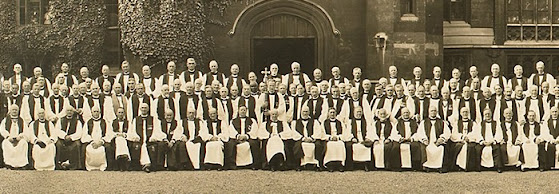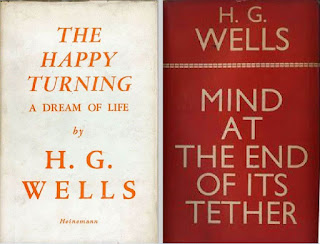Primate (pronounced prahy-meyt
or prahy-mit)
(1) In the
ecclesiastical hierarchy, an archbishop or bishop ranking first among the
bishops of a province or country (in this context usually pronounced prahy-mit).
Primate is a title or rank bestowed on some archbishops in some Christian
churches and can, depending on tradition, denote either jurisdictional
authority or mere ceremonial precedence.
(2) In zoology,
any of various omnivorous mammals of the order primates (including simians and
prosimians), comprising the three suborders anthropoidea (humans, great apes,
gibbons, Old World monkeys, and New World monkeys), prosimii (lemurs, loris,
and their allies), and tarsioidea (tarsiers), especially distinguished by the
use of hands, varied locomotion, and by complex flexible behavior involving a
high level of social interaction and cultural adaptability: a large group of
baboons is called a congress which,
to some, makes perfect sense.
(3) A
chief or leader (archaic).
1175-1225:
In the sense of "high bishop, preeminent ecclesiastical official of a
province" having a certain jurisdiction, as vicar of the pope, over other
bishops in his province, primate is from the Middle English primate & primat, from the Old French primat
and directly from the Medieval Latin primatem
(church primate), a noun use of the Late Latin adjective primas (of the first rank, chief, principal) from primus (first). The meaning "animal of the biological
order including monkeys and humans" is attested from 1876, from the Modern
Latin Primates, the order name (linnæus),
the plural of the Latin primas; so
called for being regarded as the "highest" order of mammals (the
category originally included bats, representing the state of thought in biology
at the time).
As an adjective, prime dates from
the late fourteenth century in the sense of "first, original, first in
order of time" from the Old French prime
and directly from the Latin primus (first, the first, first part (figuratively
"chief, principal; excellent, distinguished, noble") from the Proto-Italic
prismos & priisemos, superlative of the primitive Indo-European preis- (before), from the root per (beyond;
before; forward), hence the sense "in front of, before, first, chief". It was the source also of the Italian and
Spanish primo and thus a doublet of primo.
The meaning "of fine quality; of the first excellence" is from
circa 1400. The meaning "first in
rank, degree, or importance" was first noted in English circa 1610 whereas
in mathematics (as in prime number), it wasn’t in the literature until the
1560s. The prime meridian (the meridian
of the earth from which longitude is measured, that of Greenwich, England) was
established in 1878. Prime time which originally
was used to describe "spring time" is attested from circa 1500. The use in broadcasting in the sense of a "peak
tuning-in period" dates from 1961.

Some endangered primates.
As a noun prime referred to the "earliest
canonical hour of the day" (6 am), from the Old English prim and the Old French prime or directly from the Medieval
Latin prima "the first service"
from the Latin prima hora (the first
hour (of the Roman day)), from the Latin primus
("first, the first, first part").
In classical Latin, the noun uses of the adjective meant "first
part, beginning; leading place". The
noun sense "apostrophe-like symbol" exists because the symbol ′ was
originally a superscript Roman numeral one.
By extension, "the first division of the day" (6-9 am) was an
early-thirteenth century form whereas the sense of "beginning of a period
or course of events" is from the late fourteenth. From the notion of "the period or
condition of greatest vigor in life" there came by the 1530s the specific
sense "springtime of human life" (taken usually to mean the ages around
21-28 (the division of live in seven-year chunks a noted motif in English) is
from the 1590s and at about the same time, prime came to mean "that which
is best in quality, highest or most perfect state of anything".
The use as a verb dates from the 1510s,
an invention by the military to describe the process (fill, charge, load)
required before a musket or other flintlock weapon could be discharged, the assumption
being this was derive from the adjective.
From this by circa 1600 evolved the general sense of "perform the
first operation on, prepare something for its intended purpose” (applied especially
to wood to make ready for painting)".
To prime a pump is noted from 1769 and meant to pour water down the tube
to saturate the sucking mechanism which made it draw up water more readily. This was later adopted in public finance and
economics to describe what is now usually called fiscal stimulus (the idea
being a little government money attracting more private investment. The suffix -ate was a word-forming element
used in forming nouns from Latin words ending in -ātus, -āta, & -ātum (such
as estate, primate & senate). Those
that came to English via French often began with -at, but an -e was added in
the fifteenth century or later to indicate the long vowel. It can also mark adjectives formed from Latin
perfect passive participle suffixes of first conjugation verbs -ātus, -āta, & -ātum (such as desolate, moderate & separate). Again, often they were adopted in Middle
English with an –at suffix, the -e appended after circa 1400; a doublet of –ee.

Lindsay Lohan and a large primate, King Kong premiere, Loews E-Walk and AMC Empire 25 Theaters, New York City, December 2005.
The Roman Catholic Church
In the Roman
Catholic Church, a Primate is almost always an Archbishop though the title is
occasionally bestowed on the (Metropolitan) bishop of an Episcopal see who has
precedence over the bishoprics of one or more ecclesiastical provinces of a
particular historical, political or cultural area. Also sometimes created are primates where the
title is entirely honorific, granting only precedence in on ceremonial
occasions and, in the case of the Polish Primates, the privilege of wearing
cardinal's crimson robes (though not the skullcap and biretta). The Vatican likes the old ways and many
primates are vested not in the capitals of countries but in those places which
were the centres of the country when first Christianized. For that reason there still exists the Primate
of the Visigothic Kingdom, and the Primate of the Gauls.
Some of
the leadership functions once exercised by Primates have now either devolved to
presidents of conferences of bishops or to Rome itself. Modern communications as much as reform of
canon law have influenced these developments and most changes were effected
between the publication of the Code of Canon Law in 1917 and the late
twentieth-century implementation of Vatican II’s more arcane administrative
arrangements. Rome
has never seemed quite sure how to deal with England. Unlike in the secular US, where the Holy See’s
grant of precedence to the Archbishop of Baltimore dates from 1848, the
Archbishop of Westminster has not been granted the title of Primate of England
and Wales but is instead described as that of Chief Metropolitan. Rome has never exactly defined the
implications of that though it has been suggested the position is “…similar to
that of the Archbishop of Canterbury.” Most
helpful.
If the
position in England remains vague, that of some of the orders is opaque. The loose structures of the Benedictine
Confederation made Pope Leo XIII (1810–1903; pope 1878-1903) exclaim that the
Benedictines were ordo sine ordine
(an order without order), something about which he subsequently did
little. The Benedictine Abbot Primate
resides at Sant'Anselmo in Rome and takes precedence of all other abbots and is
granted authority over all matters of discipline, to settle difficulties
arising between monasteries, to hold a canonical visitation, exercise a general
supervision for the regular observance of monastic discipline. However, his Primatial powers permit him to
act only by virtue of the proper law of the autonomous Benedictine congregations,
most of which does not exist. Charmingly,
the Benedictine Order appears still to operate as it’s done for the last few
centuries, untroubled by tiresome letters from Rome although other orders have
embraced modern ways. The Confederation
of Canons Regular of St Augustine democratically elects an Abbot Primate,
though his role, save for prerogative reserve powers, is ceremonial.
The Church of England

Some endangered Primates at the Lambeth Conference, London, 1930. The once almost exclusively white, male and middle class world of Anglican bishops has in recent decades become increasingly black, evangelical and even female. It seems likely it may also become increasingly gay. Although rarely spoken of, it's an open secret the Anglican church in England depends for its operation on its many gay clergy and it may be it will require only the natural processes of generational change for gay bishops to become an accepted thing. Before that, a state of tolerance or peaceful co-existence may be next step.
Anglican usage styles the bishop who heads an independent church as its primate, though they always hold some other title (archbishop, bishop, or moderator). In Anglicanism, a primate’s authority is not universally defined; some are executives while others can do little more than preside over conferences or councils and represent the church ceremonially. However,
the when the Anglicans convene a Primates' Meeting, the chief bishop of each of
the thirty-eight churches that compose the Anglican Communion acts as its
primate, though they may not be that within their own church. For example, the various United Churches of the
sub-continent are represented at the meetings by their moderators though they
become primates for the purposes of Anglican conferences. Primates are thus created for
photo-opportunities.

Winds of change: Primates at the Global Anglican
Future Conference (GAFCON), Jerusalem, 2018.
In both the Churches of England and
Ireland, two bishops have the title of primate: the archbishops of Canterbury
and York in England and of Armagh and Dublin in Ireland. The Archbishop of Canterbury, considered primus inter pares (first among equals) of
all the participants, convenes meetings and issues invitations. The title of primate in the Church of England
has no direct relationship with the ex-officio right of twenty-six bishops to
sit in the House of Lords; were the church to do away with the title, it would
not at all affect the constitutional position.
The
Orthodox Church
In the
Orthodox Church, a primate is the presiding bishop of an ecclesiastical
jurisdiction or region. Usually, the
expression primate refers to the first hierarch of an autocephalous or
autonomous Orthodox Church although, less often, it’s used to refer to the
ruling bishop of an archdiocese or diocese. In the first hierarch, the primate
is the first among equals of all his brother bishops of the jurisdiction or
diocese of which he is first, or primary, hierarch, and he is usually elected
by the Holy Synod in which he will serve. All bishops are equal sacramentally, but the most
important administrative tasks are undertaken by the bishop of the most honored
diocese. The primate of an autocephalous
church supervises the internal and external welfare of that church and
represents it in its relations with other autocephalous Orthodox churches,
religious organizations, and secular authorities. During liturgical services, his name will be
mentioned by the other bishops of the autocephalous church and the primate
mentions the names of the other heads of autocephalous Orthodox churches at
Divine services.
The liturgical duties vary between jurisdictions
but, normally, the hierarch is responsible for such tasks as the consecration
and distribution of the Holy Chrism and providing the diocesan bishops with the
holy relics necessary for the consecration of church altars and holy antimins. To this may extend other administrative
duties including convening and presiding over the meetings of the Holy Synods
and other councils, receiving petitions for admission of clergy from other
Orthodox churches, initiating the action to fill vacancies in the office of
diocesan bishops, and issuing pastoral letters addressed to the bishops,
clergy, and laity of the Church. He will
also advise his brother bishops, and when required, submits their cases to the
Holy Synod. He has the honor of pastoral initiative and guidance, and, when
necessary, the right of pastoral intervention, in all matters concerning the
life of the Church within the structure of the holy canons.




















